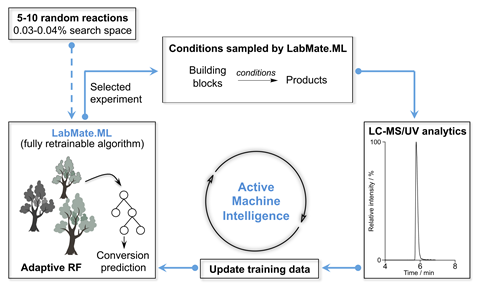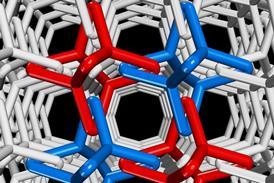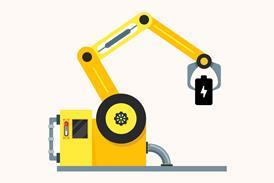
一个可以找到有机合成反应的最佳条件的免费软件工具通常和专业化学家做得一样好——这多少让研究人员感到惊讶。
该软件名为LabMate。毫升,suggests a random set of initial conditions – such as the temperature, the amount of solvent and the reaction time – for a specific reaction, with the aim of optimising its yield. After those initial reactions are carried out by a human chemist, their resulting yields are read with nuclear magnetic resonance and infrared spectroscopy, digitised into binary code and then fed back into the software. LabMate.ML then uses a machine-learning algorithm to make decisions about the yields, and then recommends further sets of conditions to try.
研究员蒂亚戈罗德里格斯里斯本大学的LabMate如是说。毫升usually takes between 10 and 20 iterations to find the greatest yield, while the number of initial reactions varies between five and 10, depending on how many conditions are being optimised.
“一开始,模型不是很好,但LabMate。毫升starts suggesting which experiments we should perform next,’ he says. ‘As more data becomes available, the models start improving and the predictions start approaching what we get in the chemistry lab.’
根据具体的反应,LabMate。毫升can determine its optimum yield in a few days – much faster than a purely manual method, Rodrigues says.
在9项概念验证研究中-包括药物发现中使用的Ugi 3组分反应,Buchwald-Hartwig交叉偶联反应和Horner-Wadsworth-Emmons烯化- LabMate。ML的表现与人类化学家专家小组相当。
罗德里格斯说:“出乎意料的是,我们的方法相对于专家来说是多么具有竞争力——有些专家有30年的合成化学实践经验。”“我们的预期是要比专家们的表现略低一点……大多数化学家都知道哪种条件最适合某种反应。”
相反,研究人员发现该软件正在探索通常被化学家忽视的参数,在某些情况下,它的成功是由于对这些参数的利用,他说。
LabMate。毫升is open source and runs on a desktop computer – the whole system requires only a single chemist and common laboratory equipment, which makes it much cheaper to operate than fully robotic systems, Rodrigues says. He thinks LabMate.ML will be an inexpensive approach to yield optimisation for labs that may not have access to what are – so far – relatively costly chemistry robots.
他说:“我不认为人工智能的化学机器人在未来10年或15年内会普及。”他说,除非有重大进展,否则我认为普通实验室无法获得这项技术。
这就有了LabMate。毫升a window of several years in which it can be useful, by freeing up human chemists to focus on other laboratory tasks, he says. ‘The goal was not to find a substitute for a chemist, but to develop a tool that could help chemists.’
格拉斯哥大学李·克罗宁他领导了其他研究化学的机器人还有机器学习2他说,新的软件工具在化学家的纯手工劳动和全自动化学系统之间架起了一座桥梁。克罗宁说,通过给出与人类专家相当的结果,“它可以让用户用机器人系统更快地完成任务”。从这个角度来看,这是非常棒的。
然而,克罗宁并不同意大多数实验室需要等待很长时间才能出现能够进行反应优化的化学机器人。他说,我认为它将在两到三年内出现,而不是10年或15年。
参考文献
1 D Reker等,细胞代表Phys。科学。, 2020, doi:10.1016 / j.xcrp.2020.100247
2 J M Granda等,自然, 2018, doi:10.1038 / s41586 - 018 - 0307 - 8











暂无评论